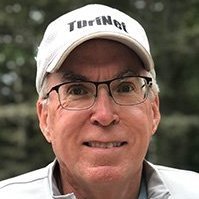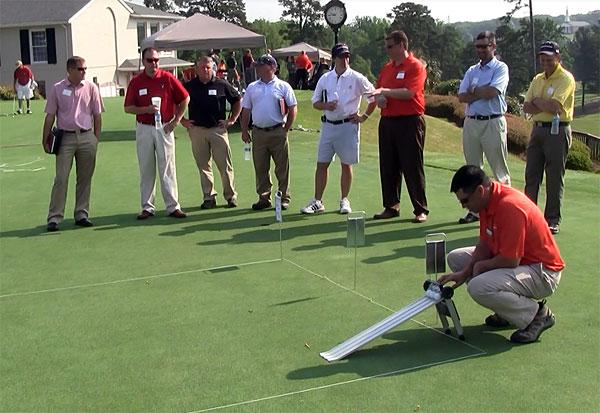 It was a hazy, hot and humid day at Greenville (SC) Country Club March 22 for the first North American Turf Science Live event, presented by Jacobsen, Syngenta, Smithco and Turfco.
It was a hazy, hot and humid day at Greenville (SC) Country Club March 22 for the first North American Turf Science Live event, presented by Jacobsen, Syngenta, Smithco and Turfco.
Approximately 60 superintendents from within a 3-hour drive radius rotated between eight stations at the outdoor field day that showcased the latest research and technological innovations in turf agronomy. The event was patterned after similar events held in England over the last several years, also sponsored by Jacobsen/Ransomes, Syngenta and local partners.
"We wanted to host a program where new technology and research could be explained and demonstrated in small group settings," said Chris Vernon, VP of Marketing and Product Management at Jacobsen. "The schedule also allowed ample time for questions from superintendents, networking among themselves and product feedback from attendees for us."
The eight stations set up across the grounds of Greenville Country Club included:
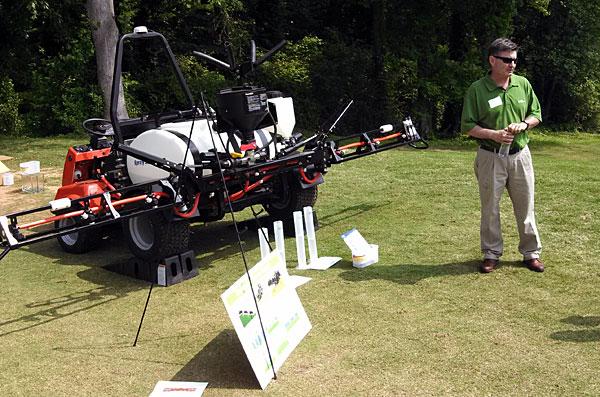 1. Turf Application On Target - Dan Kidder, Ph.D., Syngenta.
1. Turf Application On Target - Dan Kidder, Ph.D., Syngenta. Dr. Kidder talked about methods of optimizing turf spray applications through nozzle selection, sprayer pressure, sprayer calibration, mixing procedures, water volume and pH of the spray solution. He also introduced Syngenta XC spray nozzles, which are currently available in the UK but under testing in North America.
Syngenta XC nozzles (manufactured by Hypro) are specifically designed with a flexible spray pattern that maintains proper coverage on sloping ground or over contours where boom height may vary from the typical 20". They reduce drift and incorporate a rear-facing spray angle calculated to counteract the forward motion of the sprayer to deliver all-around coverage of the turf leaf.
It only makes sense for a plant protectant provider, after jumping through all the hoops and expense of product research, development and registration, to optimize the application process by supplying what they consider the ideal nozzles for each product.
2. Maximizing Putting Green Performance and Stress Tolerance - Lane Tredway, Ph.D., Syngenta.
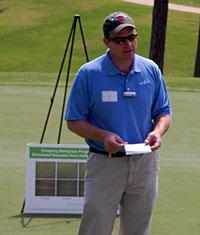 New technologies from Syngenta -- including plant activators, pigments and new fungicide chemistries -- have been incorporated into eight new products introduced by Syngenta over the last year or two. Syngenta has been working with Chuck Connolly and his staff at Greenville Country Club to develop agronomic programs to provide season-long disease control and maximum stress tolerance of bentgrass greens in the transition zone.
New technologies from Syngenta -- including plant activators, pigments and new fungicide chemistries -- have been incorporated into eight new products introduced by Syngenta over the last year or two. Syngenta has been working with Chuck Connolly and his staff at Greenville Country Club to develop agronomic programs to provide season-long disease control and maximum stress tolerance of bentgrass greens in the transition zone.An example of a plant activator is Acibenszolar-S-methyl, a component of Daconil Action. This "fortified" chlorothalonil formulation increases the turf's resistance to anthracnose, Pythium blight and bacterial wilt, while also increasing drought tolerance and overall turf quality.
Dr. Tredway explained the Syngenta Premium Program in use at Greenville Country Club, which includes Headway, Avid, Secure, Segway, Heritage, Appear, Daconil Action, Subdue Maxx and Briskway products at various rates and combinations. Half of the demonstration green was treated with this program and the other half by a similar program of competitive products.
Syngenta agronomic programs can be found at greencastonline.com/programs/
 3. The Truth About Hybrid Mowers and What it Means to You - Greg Walker, Jacobsen.
3. The Truth About Hybrid Mowers and What it Means to You - Greg Walker, Jacobsen. The Big Three turf equipment companies have all introduced "alternative" power sources over the past few years, including all-hydraulic, e-reel units, true hybrids and true all-electrics. Each also has their own spin on which is "best".
The title of this presentation was a tad misleading, as it thankfully wasn't the to-be-expected pitch for Jacobsen's choice of electric and hybrid systems, but rather a fair and relatively unbiased explanation of the various technologies including an explanation of the benefits of lithium-ion batteries compared to traditional lead acid. Greg Walker, technical training manager for Jake, did a very nice job of explaining some of the little-known nuances of performance and capabilities of the various technologies.
4. Frequency of Clip, Height of Cut and Ball Roll on the Green - Chris Fox, Jacobsen.
This demonstration utilized a Pelzmeter to measure ball roll distance on plots mowed at various heights and frequency of clip settings in an effort to show how superintendents can utilize FOC settings and adjustments to increase ball roll distance without lowering the height of cut, or maintain current BRD with a higher height of cut in stressful situations. (photo at top of page)
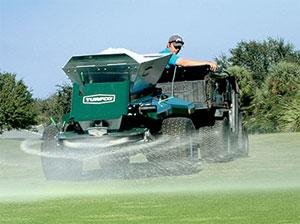 5. Precision Topdressing - Scott Kinkead, Turfco
5. Precision Topdressing - Scott Kinkead, TurfcoTurfco launched the new WideSpin 1550 topdresser at the recent GIS in San Diego (see our coverage here), and Scott Kinkead used it at Turf Science Live to highlight the new capabilities its technologies bring to topdressing.
By integrating an electronic controller (similar to those on sprayers) with hydraulic spinner drive, the WideSpin 1550 enables the superintendent to identify specific, quantified rates (rather than guessing by number of hoppers used, etc) then them dial in for different applications (greens, tees, heavy/light, wide/narrow swath). The operator has to only throw one switch on the handheld controller to start/stop the conveyor and spinners, and cannot start the conveyor before the spinners. Width of swath and application rates can be changed on the fly with no manual adjustment on the machine itself.
6. Increasing Seeding Success - George Kinkead, Turfco.
Turfco showcased their recent improvements in overseeding technology at Turf Science Live. George Kinkead gave a rundown of the technologies incorporated into the Turfco TriWave seeders to optimize seed-to-soil contact, increase germination rates and speed, reduce cleanup and turf disturbance, and reduce the amount of seed used.
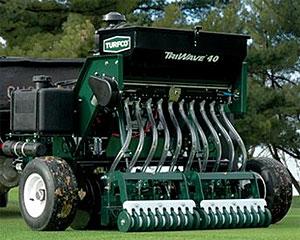 The solid 'wave' blades on the TriWave units create square, flat-bottomed slits that capture and hold seed better than traditional v-shaped slits. They also enable double- and triple-cross seeding without tearing out "pizza slices" of turf as happens with notched blades.
The solid 'wave' blades on the TriWave units create square, flat-bottomed slits that capture and hold seed better than traditional v-shaped slits. They also enable double- and triple-cross seeding without tearing out "pizza slices" of turf as happens with notched blades. Floating heads on the TriWave units enable seeding on a curve and avoid damage to sprinkler heads and high spots.
The 'hook up and go' capabilities of the tow-type TriWave 40 enable the unit to be quickly dispatched for spot seeding on a regular basis without exchanging attachments. No tools are required to adjust seed rates and depths so changes can be made in the field as required.
7. Make Spraying More Efficient, Convenient and Accurate - Doug Colley, Smithco
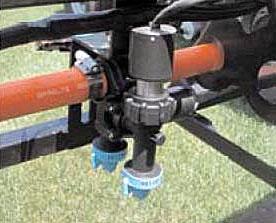
Technologies new to the professional turf market have been available and proven in agriculture for some time now. Smithco has incorporated multi-nozzle "Blended Pulse Technology" (BPT) of the Capstan Sharpshooter system to unlock the relationship between ground speed, rate, tip size and pressure, basically creating a situation where "speed no longer matters" as a discrete function of chemical delivery.
Don't confuse "multi-nozzle" in this case with turret-type nozzle heads. Multi-nozzle means two nozzles operate simultaneously at each position on the boom to allow the operator to spray at speeds of two to ten mph and at rates of 0.4 to 5.0 gallons per thousand while maintaining a constant operator-set pressure.
Solenoids are located right at each nozzle assembly so spray material and pressure are maintained to the tip for instant on/off capability.
The operator can invoke "on-demand drift control" when required by reducing the pressure for bigger droplets and fewer driftable fines. Application rate is maintained independent of this pressure change.
8. Using GPS Satellites to Guide and Control the Spray Vehicle - Emil Miller, Smithco
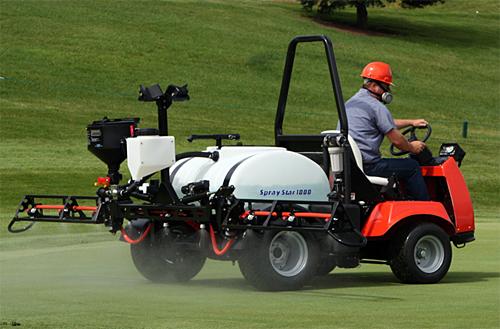 The Star Command spray system from Smithco couples the Sharpshooter BPT system to a Raven Envizio Pro II advanced rate controller which incorporates GPS technology to identify and monitor the location of the sprayer and each spray tip, and where it has been already. The system automatically controls spray application coverage down to the individual spray tips, which are turned on and off to avoid pass-to-pass overlap errors or skips.
The Star Command spray system from Smithco couples the Sharpshooter BPT system to a Raven Envizio Pro II advanced rate controller which incorporates GPS technology to identify and monitor the location of the sprayer and each spray tip, and where it has been already. The system automatically controls spray application coverage down to the individual spray tips, which are turned on and off to avoid pass-to-pass overlap errors or skips.GPS technology enables "defined boundary" applications to eliminate overspray or drift into non-target areas. By automatically shutting off nozzles that would otherwise apply material to non-target areas, significant reductions in chemical use and subsequent cost savings can be achieved.
The Star Command system records all application functions and exports it easily to a desktop computer for record-keeping, planning and analysis. The superintendent will know exactly what has been applied, where it has been applied, how well it has been applied and how long it has taken.
* * *
Conversations with various Syngenta and Jacobsen personnel after the Turf Science Live event indicated a good probability of proceeding with future events around the country. Attendees had the option of playing golf today at Greenville Country Club to wrap up the event.

